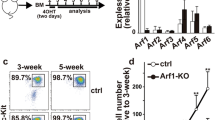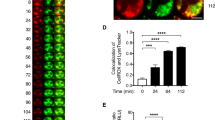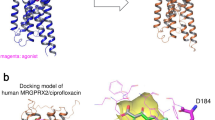Abstract
INTERACTION of multivalent ligands with receptors (immuno-globulin E, IgE) on the surface of the mast cell stimulates the calcium-dependent degranulation and secretion of histamine1,2. Secretion is also initiated by application of the calcium carrier substance (ionophore) A23187 (ref. 3), and so the effective common stimulus to this cell (and many others) is the entry of Ca2+ ions into the cytosol. The mechanism of the normal ligand-induced calcium entry process is not well understood4. Certain flavones, notably quercetin, interfere with the activity of membrane transport adenosine triphosphatases (ATPases) including the calcium-dependent ATPase which is associated with exclusion of calcium from the cytosol of cells. They are not simple ATPase inhibitors but probably act by increasing the efficiency of ion translocation, thus reducing the consumption of ATP (refs 5, 6). Also, the flavones (2-phenyl cromones) have some structural resemblance to the widely used anti-allergic drug cromoglycate whose activity may be expressed at the calcium entry pathway7. We examine here the effect of these substances on histamine secretion from mast cells.
This is a preview of subscription content, access via your institution
Access options
Subscribe to this journal
Receive 51 print issues and online access
$199.00 per year
only $3.90 per issue
Buy this article
- Purchase on Springer Link
- Instant access to full article PDF
Prices may be subject to local taxes which are calculated during checkout
Similar content being viewed by others
References
Orange, R. P., Stechschulte, D. J. & Austen, K. F. J. Immun. 105, 1087–1095 (1970).
Mongar, J. L. & Schild, H. O. J. Physiol. 140, 272–284 (1958).
Foreman, J. C., Mongar, J. L. & Gomperts, B. D. Nature 245, 249–251 (1973).
Gomperts, B. D. in Receptors and Recognition 2 (eds Cuatrecasas, P. & Greaves, M. F.) (Chapman and Hall, London, 1976).
Racker, E. in Energy Transducing Systems. MTP International Review of Science, Biochemistry Series 1, 3 (ed. Racker, E.), 163–183 (Butterworth, London, 1975).
Racker, E. Biochem. Soc. Trans. 3, 785–802 (1975).
Foreman, J. C., Mongar, J. L., Gomperts, B. D. & Garland, L. G. Biochem. Pharmac. 24, 538–540 (1975).
Suolinna, E-M., Buchsbaum, R. N. & Racker, E. Cancer Res. 35, 1865–1872 (1975).
Magro, A. M. Nature 249, 572–573 (1974).
Garland, L. G. & Mongar, J. L. Int. Archs Allerg. appl. Immun. 50, 27–42 (1976).
Freedman, M. H., Raff, M. C. & Gomperts, B. D. Nature 255, 378–382 (1975).
Foreman, J. C. & Garland L. G. Br. med. J. 1, 820–821 (1976).
Kusner, E. J., Dubnick, B., & Herzig, D. G. J. Pharmac. exp. Ther. 184, 41–46 (1973).
Rodney, G., Swanson, A. L., Wheeler, L. M., Smith, G. N. & Worrell, C. S. J. biol. Chem. 183, 739–747 (1950).
Lang, D. R. & Racker, E. Biochim. biophys. Acta 333, 180–186 (1974).
Carpenedo, F., Bortignon, C., Bruni, A. & Santi, R. Biochem. Pharmac. 18, 1495–1500 (1969).
Deters, D. W., Racker, E., Nelson, N. & Nelson, H. J. biol. Chem. 250, 1041–1047 (1975).
Cantley, L. C. & Hammes, G. G. Biochemistry 15, 1–8 (1976).
Cooper, P. H. & Stanworth, D. R. Biochem. J. 156, 691–700 (1976).
Sugiyama, K. Jap. J. Pharmac. 21, 531–539 (1971).
Aisenberg, A. C. The Glycolysis and Respiration of Tumors (Academic, New York, 1961).
Eden, M., Haines, B. & Kahler, H. J. natn. Cancer Inst. 16, 541–556 (1955).
Suolinna, E-M., Lang, D. R. & Racker, E. J. natn. Cancer Inst. 53, 1515–1519 (1974).
Shinebourne, E. & White, R. Cardiovasc. Res. 4, 194–200 (1970).
Lawson D., Fewtrell, C., Gomperts, B. & Raff, M. C. J. exp. Med. 142, 391–402 (1975).
Goth, A., Adams, H. R. & Knoohuizen, M. Science 173, 1034–1035 (1971).
Shore, P. A., Burkhalter, A. & Cohn, V. H. J. Pharmac. exp. Ther. 127, 182–186 (1959).
Warren, G. P., Toon, P. A., Birdsall, N. J. M., Lee, A. G. & Metcalfe, J. C. Proc. natn. Acad. Sci. U.S.A. 71, 622–626 (1974).
Author information
Authors and Affiliations
Rights and permissions
About this article
Cite this article
FEWTRELL, C., GOMPERTS, B. Effect of flavone inhibitors of transport ATPases on histamine secretion from rat mast cells. Nature 265, 635–636 (1977). https://doi.org/10.1038/265635a0
Received:
Accepted:
Issue Date:
DOI: https://doi.org/10.1038/265635a0
This article is cited by
-
A two-gate model for the ryanodine receptor with allosteric modulation by caffeine and quercetin
European Biophysics Journal (2008)
-
Quercetin inhalation inhibits the asthmatic responses by exposure to aerosolized-ovalbumin in conscious guinea-pigs
Archives of Pharmacal Research (2008)
-
The effect of Na+-K+ ATPase inhibition by ouabain on histamine release from human cutaneous mast cells
Molecular and Cellular Biochemistry (2007)
-
Anti-asthmatic action of quercetin and rutin in conscious guinea-pigs challenged with aerosolized ovalbumin
Archives of Pharmacal Research (2007)
-
Chondroitin sulphate inhibits connective tissue mast cells
British Journal of Pharmacology (2000)
Comments
By submitting a comment you agree to abide by our Terms and Community Guidelines. If you find something abusive or that does not comply with our terms or guidelines please flag it as inappropriate.



